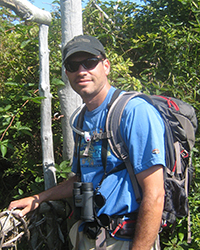Gulka, J., A. M. Berlin, K. D. Friedland, A. T. Gilbert, C. Goetsch, W. A. Montevecchi, M. Perry, I. J. Stenhouse, K. A. Williams, & E. M. Adams. 2023. Assessing individual movement, habitat use, and behavior of non-breeding marine birds in relation to prey availability in the US Atlantic. Marine Ecology Progress Series 711: 77-99.
Goetsch, C., J. Gulka, K. D. Friedland, A. J. Winship, J. Clerc, A. Gilbert, H. F. Goyert, I. J. Stenhouse, K. A. Williams, J. R. Willmott, M. L. Rekdahl, H. C. Rosenbaum, & E. M. Adams. 2023. Surface and subsurface oceanographic features drive forage fish distributions and aggregations: Implications for prey availability to top predators in the US Northeast Shelf ecosystem. Ecology and Evolution 13.
Adams, E. M., I. J. Stenhouse, A. T. Gilbert, J. Boelsma, G. Gress, C. S. Weidensaul, C. Grigsby, E. J. Williams, L. Phillips, & C. L. McIntyre. 2022. The first documentation of the Nearctic–Paleotropical migratory route of the Arctic Warbler. Ecology and Evolution 12.
Stenhouse, I. J., A. M. Berlin, A. T. Gilbert, M. W. Goodale, C. E. Gray, W. A. Montevecchi, L. Savoy, & C. S. Spiegel. 2020. Assessing the exposure of three diving bird species to offshore wind areas on the U.S. Atlantic Outer Continental Shelf using satellite telemetry. Diversity and Distributions 26. Available at https://onlinelibrary.wiley.com/doi/full/10.1111/ddi.13168.
Paruk, J. D., I. J. Stenhouse, B. J. Sigel, E. M. Adams, W. A. Montevecchi, D. C. Evers, A. T. Gilbert, M. Duron, D. Long, J. Hemming, & P. Tuttle. 2019. Oiling of American White Pelicans, Common Loons, and Northern Gannets in the winter following the Deepwater Horizon (MC252) oil spill. Environmental Monitoring and Assessment 191: 817. Available at http://link.springer.com/10.1007/s10661-019-7925-y.
Goyert, H. F., B. Gardner, R. R. Veit, A. T. Gilbert, E. Connelly, M. Duron, S. Johnson, & K. Williams. 2018. Evaluating habitat, prey, and mesopredator associations in a community of marine birds. ICES Journal of Marine Science 75. Available at https://academic.oup.com/icesjms/article/75/5/1602/4973731.
Goyert, H. F., B. Gardner, R. R. Veit, A. T. Gilbert, E. Connelly, M. Duron, S. Johnson, & K. Williams. 2018. Evaluating habitat, prey, and mesopredator associations in a community of marine birds Browman, H. (ed). ICES Journal of Marine Science 75: 1602-1612. Available at https://academic.oup.com/icesjms/article/75/5/1602/4973731.
Sollmann, R., B. Gardner, K. A. Williams, A. T. Gilbert, & R. R. Veit. 2016. A hierarchical distance sampling model to estimate abundance and covariate associations of species and communities O'Hara, R. B. (ed). Methods in Ecology and Evolution 7: 529-537. Available at https://onlinelibrary.wiley.com/doi/abs/10.1111/2041-210X.12518.
Friedland, K. D., J. P. Manning, J. S. Link, J. R. Gilbert, A. T. Gilbert, & A. F. O’Connell. 2012. Variation in wind and piscivorous predator fields affecting the survival of Atlantic Salmon (Salmo salar) in the Gulf of Maine. Fisheries Management and Ecology 19: 22-35. Available at http://doi.wiley.com/10.1111/j.1365-2400.2011.00814.x.
Evers, D. C., K. A. Williams, M. W. Meyer, A. M. Scheuhammer, N. Schoch, A. T. Gilbert, L. Siegel, R. J. Taylor, R. Poppenga, & C. R. Perkins. 2011. Spatial gradients of methylmercury for breeding Common Loons in the Laurentian Great Lakes region. Ecotoxicology 20: 1609-1625. Available at http://link.springer.com/10.1007/s10646-011-0753-7.



